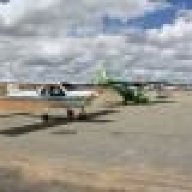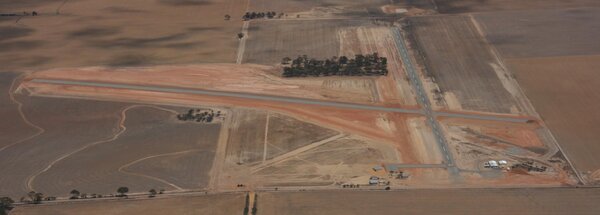-
Posts
57 -
Joined
-
Last visited
Content Type
Profiles
Forums
Gallery
Downloads
Blogs
Events
Store
Aircraft
Resources
Tutorials
Articles
Classifieds
Movies
Books
Community Map
Quizzes
Posts posted by flyinghigh
-
-
The wording on CASA's website is "They should have a screen approximately A5 therefore, have a screen size of at least A5 i.e. 210 x 148 mm; 8.3 x 5.8 in. A PDA can only be used for calculations". Kinda interesting that it says "should", not "must". So, definitely a little grey around whether the iPad Mini is suitable (device size is 200 x 134 mm - screen is less than that).Taken from the above link, the MINIMUM screen size is calculated to be 257mm or 10.1" (210 x 148 mm; 8.3 x 5.8 in), so no iphones or equivalent or even small tablets.-
 1
1
-
-
Ha! My RV3 has a bullet hole through the left flap and into the fuse (behind the seat). For some reason, it was shortly after that incident that the original builder sold it!
-
A member of the Beverly Soaring Society, Alfred Rosche. He was attending the wave camp being held at the Stirling Ranges.
-
You could start with a general read through the safety articles on VAF: http://www.vansairforce.net/safety.htm (and search through the VAF forums as already suggested).
There's a book about it: http://www.amazon.com/Flight-Testing-Homebuilt-Aircraft-Vaughan/dp/0813813085 ; probably more than one!
The SAAA publish a "Flight Test Guide" (provided with their CofA kit, but possibly also available by purchase).
And of course Google can refer you to many many other articles, some of which are worth reading.
Ultimately, you have to ask yourself: am I actually the right person to conduct the flight testing of my aircraft? For instance, if you develop a fault during flight, will you act to save yourself or the plane (after all, you probably have 100's if not 1000's of hours invested in its construction)?
-
Sorry to hear that you're struggling to get anywhere with the training. The basic inference being made here is that training in an experimental (19- reg) is not permitted unless it's your own aircraft. There may be other circumstances where it's ok, but basically an aircraft used for flight training must be 24- registered (for more modern types) and maintained by a L2 engineer.
-
Different airstrips, different rules. Moorabbin seems to charge a daily rate (which I guess means do as much as you like for the day). Jandakot (WA) has landing AND touch & go fees. Check ERSA and websites for aerodromes to work it out.
If only a landing fee is listed, usually you only pay for the full-stop. If there is any confusion in the information provided, contact the AD operator by phone for clarification.
-
As far as I can tell, the Sonex is a kit-build aircraft. You're therefore not going to find an official flight manual anywhere, as it's up to the builder to develop the manual themselves. If you search through Sonex forums or mailing lists, you may come across someone who's willing to share. Is said aircraft a 19- reg?
-
Yes, thought of that later, didn't get a chance to edit my post. Doesn't really matter though ... let's just hope the chap pulls through.1. Yes, you can get instruction in your own home built. Build the plane, get someone to test fly it, get instruction.2. This is the media, it could be a first flight of a new home built? -
Am hoping the comment in the above newspaper is incorrect, "It was his first solo flight". In a 19- reg?
Regardless, heres hoping for a full recovery.
-
Simple answer: no. You're an RAAus licensed pilot, flying in a GA aircraft. You are not licensed to fly that aircraft. Sure, if it was a GA instructional flight, and the flight was logged out as such, then yes, it would be dual. But that it the only time you could log it dual.Hi,Just a question for those in the know. If i'm an RAA licenced pilot, and i fly in the Right hand seat of a Cessna, but actively participate in the flying and nav etc, is it ok for me to log those hours as Dual hrs in my log book?In RAAus, there is only ever one PIC. You cannot share or swap PIC duties during a flight: the person who signs out the aircraft at the start of the flight must remain PIC for the duration. If you are 'sharing' an aircraft, the only way two people can both log hours is for first person to fly to destination, then second person must sign-out for the next flight. There's a good reason for this: insurance and responsibility. If there is an accident, the person who signed out the aircraft will be recorded as the PIC by the investigators, and will be the one held responsible from a legal perspective. That person is responsible for all aspects of flight, including navigation.
Make a note in your personal diary, or put a sticky note in your log book for your personal reference: it'll be good to look back in 10 years to revisit the experience. And yes, flying into Avalon is a fantastic experience, and it's something to be remembered!We flew over to Avalon and back for the airshow. It was a good experience for me, and a great weekend to boot! -
Anyone in Perth interested in RV12 group build?
Just to throw the idea out there -- anyone in Perth (northern suburbs ideally) interested in a group build of an RV12? PM me if so!
-
I doubt that the intention is to allow operations or training in Class C here. I would have thought that as there is no CTA endorsement currently available in RAAus, you are only being exempted for operations and training in/out of Jandakot (Class D) airspace, including solo student flight. There may be some Class C operations training, but at the end of the day, the sticker only covers you for operations in the school aircraft, which is quite limiting.Thanks for that vme.So basically after reading over that, I can fly into Class C with that schools aeroplane as pilot in command as long as I've received the appropriate training (stickered in logbook) and I takeoff and land at Jandakot? Although now the question is, does the transponder comply with the regulations it needs to. All I know is the aeroplane is maintained by a LAME (and L2 I suppose)Regards transponder, the exemption states it must be calibrated per regulations.
I wish these guys every success at Jandakot, they are definitely putting RAAus into the spotlight amongst GA training, and it can only serve to improve our organisation's visibility. And if/when they also offer GA training, it will likely provide an easier path for all to move onto PPL and beyond in a proven environment (without the 'we don't recognise your training' attitude that exists among some Jandakot operators).
-
Rates are pretty-much on a per-school individual basis. If you instruct casually, it won't be huge: me, I do it for the experience and find it a great way to keep current and share my love of flying, the money doesn't really come into it.
-
This is a very general statement, unless you're aware of the school that OP is referring to. There are a number of schools that DO NOT insure aircraft, and unless you've signed an agreement that says otherwise, damage to the aircraft when solo may well be your responsibility to repair.I doubt it mate. The aircraft is owned and insured by the school.Also, just because an aircraft is insured, do not assume that you are responsible only for the excess: I've heard stories where the aircraft owner demanded significantly more than the excess to be paid, in order to cover loss of future no-claim bonus etc.
Back to the OP's question: ask your school what the insurance specifics are for each aircraft used in training. If the excess is very high, or the aircraft is not insured, there are insurance products you can take out yourself to provide the cover. QBE definitely offer this, and I suspect Allianz probably does as well.
Where I train, if an aircraft is damaged during training (dual or solo) then the school will take responsibility for all expenses, included excess. But if the a/c is damaged during private hire, then the hirer will be responsible for excess.
-
Well, if a quiet word hasn't worked, send them a bill each time you pump up the tyre. Unlikely that they'll pay, but they'll soon get the point!
-
Nah, they were just improving the chance of you choosing their stretch of water for the emergency landing should your engine fail. :big_grin:Crocs up this way used to do a similiar thing when I flew over them in the Drifter (often quite high )...straight in the water they'd go...must still remember the days of terydactyls attacking them or something. -
They're rackin' up the miles this year. See the OLC scoring page. One of the guys posted some photos (elsewhere) showing 14,500' from Friday !
-
Awesome. Made a trip to Townsville for the T'birds, will have to do the same to Illawarra should this be confirmed!
-
Full details regarding how the development was funded can be found on the Wyalkatchem Shire website, along with a history of the airfield.Looks like a very good facility. Was it the shire that sealed the strip? -
Work has just finished on the upgrade to the airfield at Wyalkatchem, WA (YWKM, 31.12S 117.23E). We now have a sealed cross strip:
- Runway 09/27 sealed 1500m
- Runway 03/21 sealed 1260m (2° up slope towards south)
Visitors always welcome: no landing fees, and the local RAAus school is open every day except Monday w/ hot & cold drinks and fuel available.
- Runway 09/27 sealed 1500m
-
Fantastic work Tomo!
-
Correct. Endorsements are available for high performance ("normal cruise speed in excess of 80kts") and low performance ("normal cruise speed of less than 80kts") aircraft. See section 2.01 of the RAAus Ops Manual for these definitions.A silly question from a GA pilot who is getting back into it, and knows little about RAA.....what is a HP (high performance) licence? Does RAA distinguish from something like a Jabiru to a Drifter in licencing? CheersShane
-
I couldn't agree with you more! Perhaps I should explain the reason for my original post: looking at a number of websites for RAAus training schools recently, I'm left wondering how many people read these and think "it'll only take 20 hours" or "it'll only cost this much". So, I pose the question so our readers can see some real numbers from real people.Too much emphasis placed on the hours. This has been a selling point and some times a problem with students who feel that they should have soloed at a certain time. -
How many hours did you log to obtain your pilot's certificate (high-performance)? What aircraft did you train in? I'm interested to see how much the type of aircraft people use for training correlates to the hours taken to license.
And if you started training in the last few years, did you believe when you started that it would take only 20 hours?




Flight in Class D Airspace
in Student Pilot & Further Learning
Posted